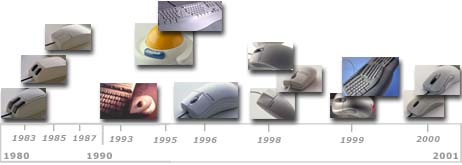REDMOND, Wash., July 16, 2001 — There are 44,000 employees at Microsoft who help create some of the world’s most innovative and recognized software. This is probably not a surprising figure, considering the ubiquity of Microsoft products in stores, homes and offices around the globe.
What may come as a surprise is that only 200 of the company’s employees build Microsoft’s best-selling, award-winning hardware — its mice and keyboards. Comprised of engineers, industrial designers, ergonomists, technologists and business pros, this relatively small team creates products that help users be more efficient in their favorite software programs while improving comfort and style.

Hardware Timeline
It began in 1982, with Microsoft’s first PC-specific mouse, invented to function concurrently with Microsoft Word. Twenty years after that first mouse hit the market for retail sale, Microsoft continues to evolve the hardware category from PC incidentals to comfortable, high-performance essentials.
“Our team began by making a mouse that served the needs of a single application, helping people interact with software more efficiently,” said Matt Barlow, product manager for the Desktop Productivity Group. “Today, we still keep to that mission, yet we’ve dramatically improved our design and engineering approaches to not only revolutionize user performance, but to provide improved comfort and style.”
The mission of the “Desktop Productivity” group (the name refers to the traditional desktop, not the kind found on computer screens) is to make mice and keyboards as useful as possible. The team relies on years of thorough user research and extensive industrial design trials, taking a hands-on approach to each product’s form and function.
Microsoft’s development team spans all relevant disciplines, as a lot of work goes into making mice and keyboards that impress consumers and that break through the clamor of the competitive hardware market. While a core group of technologists work to maximize function, ergonomists work to ensure hand and wrist alignment for greater comfort, and designers help keep these core desktop products stylish. And not necessarily just on desks — in 1993 the BallPoint mouse launched aboard the U.S. space shuttle Discovery.
As the Hardware group grew, it continued to create the kind of designs and technologies that have revolutionized input devices and the way people interact with them. The team repeatedly launched improvements to existing mice for unique purposes, from the first mouse designed for children — the Microsoft Easyball — to the Microsoft BallPoint mouse for laptops. It also invented new ways for people to interact with software, such as the now familiar scroll wheel, which was added to the Microsoft Mouse 2.0 in 1996.
The group again made history in 1999 with the greatest advance in the mouse’s 40-year history: optical technology. While the rollerball mouse, invented by Douglas Engelbart in 1963, remained the predominant tracking mechanism, Microsoft’s Hardware design team created a better performing mouse that set a new standard in tracking speed and accuracy.
“The mouse hadn’t seen many noteworthy improvements until optics were invented,” says Carl Ledbetter, industrial design manager at Microsoft. “So the sudden demand for a new product allowed us to use newer concepts like better trackballs and faster, more reactive cursor control.”
Microsoft’s first optical mouse, the IntelliMouse Explorer, came equipped with what was essentially a tiny digital camera that captured up to 1,500 frames per second. For the first time, the mouse’s precise, smooth-moving cursor was usable on virtually any surface — from a desktop to blue jeans. The Explorer, along with two other optical mouse products, breathed new life into mouse technology and design.
During the 1990s, the Hardware team also developed new keyboards and improved on previous models. Voluminous user research emphasized the importance of a comfortable keyboard that also offered greater functionality.
In response to consumer needs, Microsoft’s Natural Keyboard was unveiled in 1994 as one of the first keyboards to showcase a split line of keys, arched to accommodate the natural reach of hands on a desk. The unique design is a Microsoft Hardware hallmark, and helped establish “ergo keyboards” as a significant new product category.
“Our research proved time and time again that comfort plays an essential role in computer hardware,” says Edie Adams, manager of Hardware User Research. “With the Natural Keyboard we fused convenient, practical features with a desktop object that many people have their hands on for several hours every day.”
Beyond its comfort and style, new features such as Internet and multimedia hot keys were integrated into the Natural Keyboard to reduce hand and finger movements, increasing efficiency. These features were so well received that they were added to flat keyboards, in addition to new on-keyboard USB ports for popular desktop accessories to accommodate game controls, mice and media players.
Nineteen years and a myriad of design and technology awards later, the Hardware group continues to lead in its field. In March the team introduced IntelliEye mouse technology, a new proprietary chip that enables an optical lens to capture up to 6,000 frames per second — 42 percent faster than any other optical chip. The new technology will be integrated into Microsoft’s latest wired and wireless products this fall.
Also this fall Microsoft will launch a new keyboard, featuring a smarter, dual-handed design and customizable keys for the ultimate in fingertip efficiency, underscoring the keyboard’s important role in desktop productivity.
With PC hardware gaining more and more attention, consumers are now recognizing what Microsoft’s Desktop Productivity team has known for 20 years: “peripherals” are essential to improving overall computing experience, and the best is yet to come.




